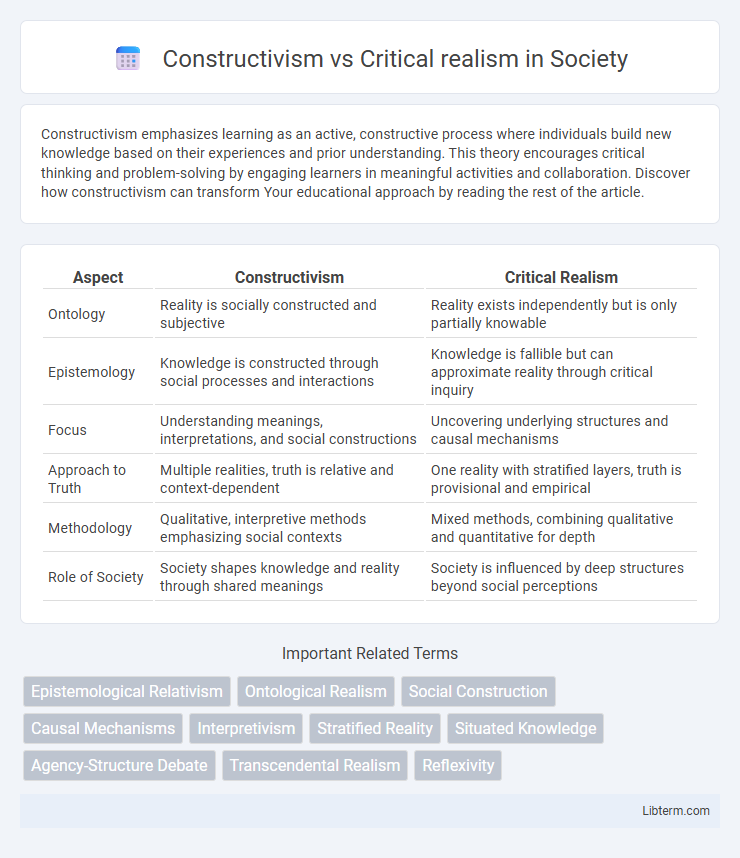Constructivism emphasizes learning as an active, constructive process where individuals build new knowledge based on their experiences and prior understanding. This theory encourages critical thinking and problem-solving by engaging learners in meaningful activities and collaboration. Discover how constructivism can transform Your educational approach by reading the rest of the article.
Table of Comparison
| Aspect | Constructivism | Critical Realism |
|---|---|---|
| Ontology | Reality is socially constructed and subjective | Reality exists independently but is only partially knowable |
| Epistemology | Knowledge is constructed through social processes and interactions | Knowledge is fallible but can approximate reality through critical inquiry |
| Focus | Understanding meanings, interpretations, and social constructions | Uncovering underlying structures and causal mechanisms |
| Approach to Truth | Multiple realities, truth is relative and context-dependent | One reality with stratified layers, truth is provisional and empirical |
| Methodology | Qualitative, interpretive methods emphasizing social contexts | Mixed methods, combining qualitative and quantitative for depth |
| Role of Society | Society shapes knowledge and reality through shared meanings | Society is influenced by deep structures beyond social perceptions |
Introduction to Constructivism and Critical Realism
Constructivism emphasizes knowledge as a social construct shaped by human experiences and interactions, prioritizing subjective understanding over objective reality. Critical realism, in contrast, recognizes an objective reality independent of human perception but acknowledges that our knowledge of this reality is mediated by social and cognitive processes. Both paradigms influence qualitative research by balancing the interpretation of meaning with an understanding of underlying structures and mechanisms.
Philosophical Foundations of Constructivism
Constructivism, rooted in epistemological idealism, emphasizes that knowledge is actively constructed through social interactions and experiences rather than passively received. This philosophy foregrounds subjective realities shaped by cultural, historical, and linguistic contexts, contrasting with the objective stance of critical realism. The constructivist framework challenges the notion of a singular, independent reality by advocating for multiple, coexisting interpretations influenced by human cognition and interaction.
Core Principles of Critical Realism
Critical Realism emphasizes the existence of a reality independent of human perceptions, focusing on the stratified nature of the world comprising the empirical, actual, and real domains. It asserts that causal mechanisms exist beneath observable phenomena, which can be uncovered through scientific inquiry despite being partially accessible. This ontology contrasts with Constructivism's emphasis on social constructions and subjective interpretations, highlighting Critical Realism's commitment to objective knowledge about underlying structures and generative mechanisms.
Ontological and Epistemological Differences
Constructivism posits that reality is socially constructed, emphasizing subjective experiences and multiple realities, which reflects its ontological relativism. Critical realism asserts an independent, mind-independent reality, highlighting ontological realism and the stratified nature of existence. Epistemologically, constructivism supports interpretivist approaches focusing on context-dependent knowledge, whereas critical realism advocates for a transitive epistemology that balances context-specific understanding with the pursuit of objective truths.
Constructivism in Social Sciences
Constructivism in social sciences emphasizes that knowledge and reality are socially constructed through interaction, language, and shared meanings within cultural and historical contexts. It challenges the notion of objective reality by stressing how individuals and groups create subjective understandings that shape social phenomena. This paradigm contrasts with critical realism by focusing on the interpretive dimensions of social life rather than positing an independent reality accessible through scientific inquiry.
Critical Realism’s Approach to Causality
Critical realism understands causality as layered and generative, where underlying mechanisms and structures produce observable events rather than simple cause-effect chains. This approach emphasizes identifying hidden causal powers that operate independently of human perception, contrasting with constructivism's focus on social constructions and meanings. By recognizing the stratified nature of reality, critical realism provides a robust framework for exploring how causal forces underpin complex social phenomena.
Methodological Implications for Research
Constructivism emphasizes qualitative methods that explore subjective meanings and social constructions, prioritizing interpretive approaches such as ethnography and narrative analysis to understand participant perspectives. Critical realism advocates for a mixed-methods approach, combining qualitative data to capture lived experiences with quantitative techniques to uncover underlying causal mechanisms and structures. This ontological distinction guides researchers to carefully align methods with their epistemological commitments, ensuring rigor in capturing both observable phenomena and hidden realities.
Strengths and Limitations of Constructivism
Constructivism excels in emphasizing the subjective nature of knowledge, highlighting how social contexts and human interactions shape understanding, which makes it valuable for exploring complex social phenomena. Its strength lies in fostering deep insights through qualitative methods and acknowledging multiple realities, but it faces limitations such as potential challenges in achieving objectivity and generalizability. Critics argue that constructivism may struggle with scientific rigor and empirical verification when compared to critical realism, which balances understanding underlying structures with the interpretation of perceptual experiences.
Strengths and Limitations of Critical Realism
Critical realism bridges the gap between positivism and constructivism by recognizing an objective reality shaped by social structures while allowing for subjective interpretation. Its strength lies in uncovering deeper causal mechanisms beyond observable events, offering robust explanations of social phenomena. Limitations include its complex philosophical language and challenges in empirical validation, making it less accessible for straightforward application in research compared to constructivism.
Choosing Between Constructivism and Critical Realism
Choosing between constructivism and critical realism depends on the research objectives and ontological assumptions about reality. Constructivism emphasizes knowledge as socially constructed and prioritizes understanding subjective experiences, while critical realism acknowledges an independent reality but stresses the importance of identifying underlying structures and causal mechanisms. Researchers aiming to balance empirical observation with a deeper analysis of causality may find critical realism more suitable, whereas those focusing on interpretive meaning may prefer constructivism.
Constructivism Infographic

 libterm.com
libterm.com